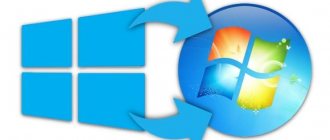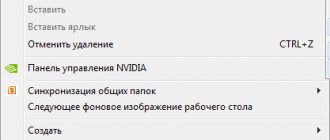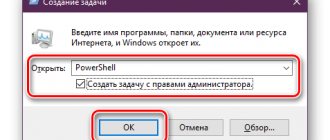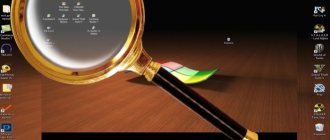Today we’ll look at what to do if shortcuts have disappeared from your Windows 7 desktop. Let us touch upon two cases:
- the shortcuts themselves are missing, “Start” and “Taskbar” are functioning;
- Everything has disappeared from the desktop except the background image, and sometimes even that is missing.
You should not go to extremes and think about reinstalling the operating system: almost all icons can be quickly returned. How to do this, read our guide for beginners.
Activating the icon display function
A beginner may not even suspect that all the elements from the desktop on his computer have disappeared because someone inadvertently activated the option to hide icons. Let's turn it off.
- Open the desktop context menu.
- Select the last item in the drop-down list.
As a result of the action, the image will be updated and you will see all your missing elements.
Check your computer for Trojans and viruses
An antivirus with the latest updates will help you.
We also strongly recommend using healing utilities like Dr.Web CureIt. They are free. These utilities do not replace an antivirus, but sometimes they find malicious applications and files that antiviruses cannot find.
Dear users! If our site helped you or there was something you didn’t like about it, we will be glad if you leave a comment. Thank you very much in advance.
Source
No context menu
If there is no response to a right click on a free area of the screen, most likely you have problems with the application that is responsible for the graphical interface. First of all, you should get an antivirus program and scan your system for viruses.
The second step is to launch Explorer. For some reason, the program did not start or its work was terminated (by the user or a virus that could replace the explorer.exe process).
- Open the “Task Manager” using + + .
- Click “File” -> “New task”.
- Enter “explorer.exe” and click .
After this, the icons on the desktop and the “Start” with the “Taskbar” should appear.
Tray icons (notification area) are missing
If one or more icons have disappeared from the Windows notification area (around the clock), here are the first steps to try:
- Right-click on the clock and select “Customize notification icons” from the context menu.
- See what settings are available for different icons. To ensure that the icon is always displayed, select “Show icon and notifications.”
- To separately configure only system icons (sound, volume, network, and others), you can click the “Turn system icons on or off” link at the bottom.
If this doesn't help, move on.
Problem appears after reboot
If the desktop becomes empty after restarting the computer, you will have to dig into the system registry keys.
- Press +.
- Type “regedit” and click “OK” to execute the command.
- Expand the “HKLM” hive, and in it go to the “Software” folder.
- Open the section shown in the screenshot.
- If it contains a subsection “explorer.exe”, delete it through the context menu.
- We go to the next section along the path shown in the screenshot.
- We look at the value of the “Shell” parameter. If it says “explorer.exe”, then everything is fine. Otherwise, indicate the correct value.
The changes will take effect after you restart your computer.
How to restore desktop shortcuts in Windows 7 and 8 using Registry Editor
Another way to restore shortcuts is to use the Registry Editor program.
Important! It is suitable for experienced people, since one incorrect deletion or change of a key can lead to very serious consequences for the Windows 7 operating system.
However, if none of the above helped, then you will have to go to the registry. The thing is that malicious software that could have entered the computer with an infected game or application blocks the launch of the Explorer file and activates its services instead. The Registry Editor helps correct the situation.
You need to do the following:
- Go to the Start menu and enter “Registry Editor” in the search bar. You can also run it from the Run window by typing “regedit”. If you can’t enter “Device Manager” or “Start”, then you need to try to boot the operating system in safe mode.
- Go to the “Registry Editor” and find the “Winlogon” folder, following the path: HKEY_LOCAL_MACHINE\SOFTWARE\Microsoft\WindowsNT\CurrentVersion\Winlogon.
- View the "Shell" parameter and see what it means. It should say "explorer.exe". If the value is different, then the problem is a virus that changed the configuration.
- Double-click on the “Shell” parameter and change its value to “explorer.exe” by clicking on “Ok”.
- Restart your personal computer or laptop to check the results. The shortcuts should come back.
Running a program through the Run utility
Disabling the service tool
This tool checks each desktop shortcut for functionality. If there is a shortcut, but there is no file (referring to an inaccessible location or a deleted file), the program will delete such an object. If the desktop contains links to removable drives or network directories, which sometimes become inaccessible and are defined as non-working, their number must be reduced to a maximum of 4 pieces. Create a separate directory for such objects or pin them to the “Taskbar”.
Also, so that not a single such icon disappears, you can disable the system maintenance tool.
- It is launched through the “Control Panel” - open it.
- Click on the “System and Security” element.
- Through the search bar (top right) we find the “Troubleshooting” object and click on it.
Reasons for missing labels
Built-in virtualization and persistent memory services are responsible for displaying application shortcuts (icons) on the desktop. If at least one of these components fails, problems appear with displaying the contents of the workspace.
Reasons for missing label:
The program was deleted - the most common but common reason. If several people use one computer at once, misunderstandings may arise with the removal of programs. You could also accidentally delete the application's root folder on your hard drive or uninstall the software and forget about it;
A one-time crash in Windows Explorer;
The program has been uninstalled
Click on the system search field and enter “Installation and removal”;
Open the found window. In earlier versions of Windows, you need to open the Control Panel using the Start menu and find the desired field in the window;
In the window that opens, check the list of applications and find if the required software is not in the list, it has been removed from the system. Re-installation is required, after which the shortcut will appear on the desktop again.
Method 2 – Setting the display mode of desktop elements
A user of any version of Windows OS can customize the desktop: select the size of icons, define grid parameters, hide shortcuts and folders. You may have accidentally deactivated the shortcut display feature, causing them to disappear from the system.
Follow the instructions to learn how to restore Windows desktop shortcuts using the Settings panel:
Right-click on an empty area of the desktop;
In the context menu that appears, select “View”;
Then check the box next to “Display desktop icons.”
Method 3 – Registry Editor
An effective way to restore a deleted shortcut is to manually edit the necessary registry entries.
Follow the instructions:
Open the Run window by pressing the Win + R key combination;
In the new window, enter the Regedit command and confirm the action;
As a result, the Registry Editor will open. On the left side of the window, open the Local Machine-Software-Microsoft-Windows NT-Winlogon directory. A list of commands will appear on the right side of the window. Click on the Shell object and launch it.
After finishing working with the system registry, it is recommended to restart the computer. After restarting the operating system, all shortcuts will return to the desktop.
If all else fails
In principle, we did everything to show hidden objects on the desktop. If the problem does not go away or appears again over time, use the AVZ utility.
- Go to the link to download it.
- Open the resulting archive in Explorer and execute avz.exe.
- In the dialog, click “Extract all”.
- We launch the utility and through the main menu “File” call the “System Restore” function.
- To solve the problem with shortcuts, mark the 5th, 8th and 16th points, click “Perform marked operations” and confirm the action.
All that remains is to restart the computer and check if anything disappears from the desktop.
Using third-party utilities to restore all shortcuts on the Windows 7 and 8 desktop
If everything that was written above does not help, and you cannot get into the registry editor or task manager even in safe mode, then it is recommended to resort to using third-party tools - antivirus programs, which were described at the very beginning of the material. Sometimes viruses block the downloading and scanning of well-known antiviruses, so it’s worth downloading the AVZ utility.
Note! Its advantage is that it not only scans and removes viruses, but also restores system data, revives icons and provides access to other programs.
Working with AVZ is extremely easy. The process is described in the following step-by-step instructions:
- Download the program from the official website and install it on your computer or laptop. This happens in a standard way, and there is nothing complicated about the procedure.
- Launch the AVZ utility. If this fails, you can use the “Run” window, where you enter the path to the executable file.
- Click on the “File” tab and select the “Update Database” context menu item.
- Go to the “System Restore” item located in the same tab.
- Check the ninth and sixteenth option numbers and click on “Run operation failure”.
- Wait for the check to complete and errors to be corrected. The icons should be restored without restarting the personal computer.
Installing a change using the AVZ utility
When all else fails, you will have to copy your important data, if possible, and reinstall the Windows 7 operating system. This should completely format the hard drive, but all user files will be deleted.
If icons have disappeared from the Windows 7 desktop, then there is no need to panic. Just follow the instructions above and everything will work out.
Showing hidden elements
It is also possible that all your shortcuts did not disappear, but only received hidden status. You can change everything back in the Explorer service.
- Let's start the service. To do this, just press the Win + E key combination on your keyboard.
- Go to the “Desktop” directory.
- Click on the “View” option.
- Select the “Show or Hide” section.
- Check the “Hidden elements” option.
Enabling display of shortcuts
Disappearance of desktop icons can happen for a variety of reasons. First of all, it is quite possible that the specified function has been manually deactivated using standard means. The problem may also be caused by a malfunction of the explorer.exe process. The possibility of a virus infection of the system should not be discounted.
Method 1: Recovering after physically deleting icons
First of all, let's consider such a banal option as physically deleting icons. This situation can happen, for example, if you are not the only person with access to this computer. Badges can be removed by an ill-wisher simply to annoy you, or simply by accident.
- To check this, try creating a new shortcut. Right-click (RMB) on a location on the desktop. In the list, select “Create”, then click “Shortcut”.
In the shortcut creation shell, click “Browse...”.
Then click "Next".
In the next window, click “Done”.
If the shortcut appears, it means that all icons that previously existed have been physically removed. If the shortcut does not appear, this means that the problem should be looked for elsewhere. Then try to solve the problem using the methods discussed below.
The "Trash" window opens. If you see missing labels there, consider yourself lucky. The fact is that during standard deletion, files are not completely deleted, but are initially sent to the Recycle Bin. If, in addition to icons, there are other elements in the “Basket”, then select the ones you need by clicking on them with the left mouse button (LMB) and simultaneously holding down Ctrl. If the “Trash” contains only objects that need to be restored, then you can select all the contents by pressing Ctrl+A. After this, right-click on the selection. Select "Restore" from the menu.
- The icons will return to the desktop.
But what to do if the “Cart” is empty? Unfortunately, this means that the objects have been completely deleted. Of course, you can try to perform recovery by using special utilities. But this will be akin to shooting sparrows from a cannon and will take a lot of time. It will be faster to create frequently used shortcuts manually again.
Method 2: Enable icon display in the standard way
The display of desktop icons can be disabled manually. This could be done by another user as a joke, by small children, or even by mistake by you. The easiest way to fix this situation is.
- To find out if the reason your shortcuts are disappearing is because they were disabled as a standard, go to your desktop. Right-click anywhere on it. In the menu that appears, place the cursor on the “View” position. Look for the “Show desktop icons” option in the drop-down list. If there is no checkmark next to it, then this is the cause of your problems. In this case, you just need to click on this item with LMB.
Method 3: Start the explorer.exe process
Icons on the desktop may also disappear due to the fact that the explorer.exe process is not running on the PC. This process is responsible for the operation of Windows Explorer, that is, for the graphical display of almost all elements of the system, except for wallpaper, including desktop shortcuts. The main sign that the reason for the absence of icons lies precisely in the disabling of explorer.exe is that the “Taskbar” and other controls will also be missing on the monitor.
Disabling this process can happen for many reasons: system failures, incorrect interaction with third-party software, virus penetration. We will look at how to reactivate explorer.exe so that the icons return to their original place.
- First of all, bring up the “Task Manager”. In Windows 7, the Ctrl+Shift+Esc set is used for these purposes. Once the tool is invoked, move to the Processes section. Click on the name of the “Image name” field to arrange the list of processes in alphabetical order for easier searching. Now look for the name “Explorer.exe” in this list. If you find it, but the icons are not displayed and it has already been determined that the reason is not due to manually disabling them, then the process may not be working correctly. In this case, it makes sense to forcefully terminate it and then restart it.
For these purposes, select the name “Explorer.exe”, and then click on the “End process” button.
A dialog box will appear warning you that ending the process may result in the loss of unsaved data and other problems. Since you are acting purposefully, click “End process”.
Next, select “New task (Run...)”. The Run tool shell appears. Enter the expression:
Method 4: Fixing the system registry
If using the previous method it was not possible to activate explorer.exe or if after restarting the computer it disappeared again, then the problem of missing icons may be due to problems in the registry. Let's see how we can fix them.
Since manipulations with entries in the system registry will be described below, we strongly advise you to create an OS restore point or a backup copy before moving on to specific actions.
- To go to the Registry Editor, use the Win + R combination to open the Run tool. Enter:
A shell called “Registry Editor” will be launched, in which you will need to perform a number of manipulations. To navigate through registry sections, use the tree-shaped navigation menu, which is located on the left side of the editor window. If the list of registry keys is not visible, then click on the name “Computer”. A list of the main registry keys will open. Go to the name “HKEY_LOCAL_MACHINE”. Next, click “SOFTWARE”.
A very large list of sections opens. In it you need to find the name “Microsoft” and click on it.
Again a long list of sections opens. Find “WindowsNT” in it and click on it. Next, go to the names “CurrentVersion” and “Image File Execution Options”.
A large list of subsections opens again. Look for subsections named “iexplorer.exe” or “explorer.exe” in it. The point is that these subsections should not be here. If you find both or one of them, then these subsections should be deleted. To do this, click on the name of the RMB. From the drop-down list, select “Delete”.
After this, a dialog box appears asking whether you really want to delete the selected subsection with all its contents. Click "Yes".
In the generated object, instead of the name “New parameter...”, enter “Shell” and click Enter. Then you need to make a change in the properties of the string parameter. Double-click on the name.
The “Change String Parameter” shell is launched. Enter the entry “explorer.exe” in the “Value” field. Then press Enter or OK.
But there are cases when a string parameter exists in the right place, but the “Value” field is empty or it corresponds to a name other than “explorer.exe”. In this case, you need to perform the following actions.
- Go to the “Change string parameter” window by double-clicking on the name with LMB.
In the “Value” field, enter “explorer.exe” and click “OK”. If a different value is specified in this field, first delete it by highlighting the entry and pressing the Delete button on the keyboard.
Method 5: Antivirus scan
If these solutions to the problem did not help, then there is a possibility that your computer is infected with viruses. In this case, you need to scan the system with an antivirus utility. For example, you can use the Dr.Web CureIt program, which has proven itself very well in such cases. It is recommended to perform the scan not from a theoretically infected computer, but from another machine. Or use a bootable flash drive for this purpose. This is due to the fact that when performing an operation from an already infected system, there is a high probability that the antivirus will not be able to detect the threat.
During the scanning procedure and if malicious code is detected, follow the recommendations that the anti-virus utility gives in the dialog box. After virus removal is complete, you may need to activate the explorer.exe process through the “Task Manager” and “Registry Editor” using the methods discussed above.
Method 6: Rollback to a restore point or reinstall the OS
If none of the methods discussed above helped, then you can try to roll back to the last system restore point. An important condition is the presence of such a recovery point at the time when the icons were displayed normally on the desktop. If a restore point was not created during this period, then you will not be able to solve the problem this way.
If you still do not find a suitable restore point on your computer or rolling back to it does not help solve the problem, then in this case the most radical option to resolve the situation remains - reinstalling the operating system. But this step should be approached only when all other possibilities have been tested and have not given the expected result.
As you can see from this lesson, there are quite a few different reasons why desktop icons may disappear. Each reason, naturally, has its own way to solve the problem. For example, if the display of icons was disabled in the settings using standard methods, then no manipulation of processes in the Task Manager will help you return the shortcuts to their place. Therefore, first of all, you need to establish the cause of the problem, and only then start solving it. It is recommended to search for the causes and perform recovery manipulations in exactly the order presented in this article. You should not immediately reinstall the system or roll it back, because the solution can be very simple.
Source











